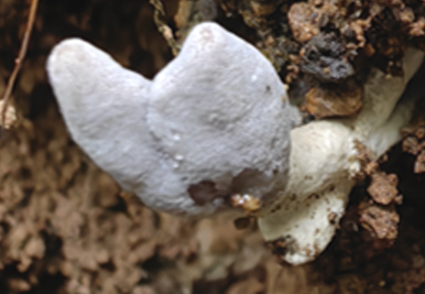Abstract
A new species of Papiliomyces, named as Papiliomyces albostromaticus, was discovered from Deze Village, Zhanyi District, Qujing City, Yunnan Province, China. It was characterized by producing clavate, white stromata, cylindrical, black to greyish white fertile part, completely immersed, long ovoid or teardrop perithecia, cylindrical asci, cylindrical conidiophores, ampoule shaped phialides, ellipse or oval conidia. Based on the combined dataset of ITS, nrSSU, nrLSU, tef-1α, rpb1 and rpb2, multigene phylogenetic analysis showed that the specimens of this species formed a distinct clade with satisfactory bootstrap support, indicating the presence of a novel species of the genus Papiliomyces. The new species was described and illustrated in the present study. The phylogenetic tree would provide a basis for a phylogenetic study of Papiliomyces and its related genera.
References
- Bischoff, J.F., Rehner, S.A. & Humber, R.A. (2006) Metarhizium frigidum sp. nov.: A cryptic species of M. anisopliae and a member of the M. flavoviride complex. Mycologia 98: 737–745. https://doi.org/10.3852/mycologia.98.5.737
- Bischoff, J.F., Rehner, S.A. & Humber, R.A. (2009) A multilocus phylogeny of the Metarhizium anisopliae lineage. Mycologia 101: 512–530. https://doi.org/10.3852/07-202
- Castlebury, L.A., Rossman, A.Y., Sung, G.H., Hyten, A.S. & Spatafora, J.W. (2004) Multigene phylogeny reveals new lineage for Stachybotrys chartarum, the indoor air fungus. Mycological Research 108: 864–872. https://doi.org/10.1017/S0953756204000607
- Chen, Z.H., Dai, Y.D., Chen, K., Zhang, F., Xu, L. & Wang, Y.B. (2023) Papiliomyces puniceum and Metarhizium lymantriidae: two new species from the Gaoligong Mountains in southwestern China. Phytotaxa 594 (1): 53–63. https://doi.org/10.11646/phytotaxa.594.1.3
- Darriba, D., Taboada, G.L., Doallo, R. & Posada, D. (2012) jModelTest 2: Moremodels, new heuristics and parallel computing. Nature Methods 9: 772–772. https://doi.org/10.1038/nmeth.2109
- Kepler, R.M., Sung, G.H., Ban, S., Nakagiri, A., Chen, M.J., Huang, B., Li, Z. & Spatafora, J.W. (2012a) New teleomorph combinations in the entomopathogenic genus Metacordyceps. Mycologia 104 (1): 182–197. https://doi.org/10.3852/11-070
- Kepler, R.M., Sung, G.H., Harada, Y., Tanaka, K., Tanaka, E., Hosoya, T., Bischoff, J.F. & Spatafora, J.W. (2012b) Host jumping onto close relatives and across kingdoms by Tyrannicordyceps (Clavicipitaceae) gen. nov. and Ustilaginoidea (Clavicipitaceae). American Journal of Botany 99 (3): 552–561. https://doi.org/10.3732/ajb.1100124
- Liang, Z.Q. (2007) Chinese Mycology. Volume 32, Cordyceps. Science Press.
- Liu, Y.J., Whelen, S. & Hall, B.D. (1999) Phylogenetic relationships among ascomycetes: Evidence from an RNA polymerse II subunit. Molecular Biology and Evolution 12: 1799–1808. https://doi.org/10.1093/oxfordjournals.molbev.a026092
- Liu, Z.Y., Liang, Z.Q., Whalley, A.J.S., Yao, Y.J. & Liu, A.Y. (2001) Cordyceps brittlebankisoides, a new pathogen of grubs and its anamorph, Metarhizium anisopliae var. majus. Journal of Invertebrate Pathology 78: 178–182. https://doi.org/10.1006/jipa.2001.5039
- Mongkolsamrit, S., Khonsanit, A., Thanakitpipattana, D., Tasanathai, K., Noisripoom, W., Lamlertthon, S., Himaman, W., Houbraken, J., Samson, R.A. & Luangsa-ard, J. (2020) Revisiting Metarhizium and the description of new species from Thailand. Studies in Mycology 95: 171–251. https://doi.org/10.1016/j.simyco.2020.04.001
- Rehner, S.A. & Buckley, E. (2005) A Beauveria phylogeny inferred from nuclear ITS and EF1-α sequences: Evidence for cryptic diversification and links to Cordyceps teleomorphs. Mycologia 97: 84–98. https://doi.org/10.1080/15572536.2006.11832842
- Rehner, S.A. & Samuels, G.J. (1994) Taxonomy and phylogeny of Gliocladium analysed from nuclear large subunit ribosomal DNA sequences. Mycological Research 98: 625–634. https://doi.org/10.1016/S0953-7562(09)80409-7
- Ronquist, F. & Huelsenbeck, J.P. (2003) MrBayes 3: Bayesian phylogenetic inference under mixed models. Bioinformatics 19: 1572–1574. https://doi.org/10.1093/bioinformatics/btg180
- Stamatakis, A., Hoover, P. & Rougemont, J. (2008) A rapid bootstrap algorithm for the RAxML Web servers. Systematic Biology 57: 758–771. https://doi.org/10.1080/10635150802429642
- Sun, T., Zou, W.Q., Dong, Q.Y., Huang, O., Tang, D.X. & Yu, H. (2022) Morphology, phylogeny, mitogenomics and metagenomics reveal a new entomopathogenic fungus Ophiocordyceps nujiangensis (Hypocreales, Ophiocordycipitaceae) from Southwestern China. MycoKeys 94: 91–108. https://doi.org/10.3897/mycokeys.94.89425
- Sung, G.H., Hywel-Jones, N.L., Sung, J.M., Luangsa-Ard, J.J., Shrestha, B. & Spatafora, J.W. (2007) Phylogenetic classifcation of Cordyceps and the clavicipitaceous fungi. Studies in Mycololgy 57: 5–59. https://doi.org/10.3114/sim.2007.57.01
- Tamura, K., Stecher, G., Peterson, D., Filipski, A., Nei, M. & Kumar, S. (2013) MEGA6: molecular evolutionary genetics analysis version 6.0. Molecular Biology and Evolution 30: 2725–2729. https://doi.org/10.1093/molbev/mst197
- Vilgalys, R. & Hester, M. (1990) Rapid genetic identifcation and mapping of enzymatically amplifed ribosomal DNA from several Cryptococcus species. Journal of Bacteriology 172: 4238–4246. https://doi.org/10.1128/jb.172.8.4238-4246.1990
- Wang, Y., Dai, Y.D., Yang, Z.L., Guo, R. & Yu, H. (2021) Morphological and molecular phylogenetic data of the Chinese medicinal fungus Cordyceps liangshanensis reveal its new systematic position in the family Ophiocordycipitaceae. Mycobiology 49: 297–307. https://doi.org/10.1080/12298093.2021.1923388
- Wang, Y.B., Wang, Y., Fan, Q., Duan, D.E., Zhang, G.D., Dai, R.Q., Dai, Y.D., Zeng, W.B., Chen, Z.H., Li, D.D., Tang, D.X., Xu, Z.H., Sun, T., Nguyen, T.T., Tran, N.L., Dao, V.M., Zhang, C.M., Huang, L.D., Liu, Y.J., Zhang, X.M., Yang, D.R., Sanjuan, T., Liu, X.Z., Yang, Z.L. & Yu, H. (2020) Multigene phylogeny of the family Cordycipitaceae (Hypocreales): new taxa and the new systematic position of the Chinese cordycipitoid fungus Paecilomyces hepiali. Fungal Diversity 103: 1–46. https://doi.org/10.1007/s13225-020-00457-3
- Wang, Y.B., Yu, H., Dai, Y.D., Chen, Z.H., Zeng, W.B., Yuan, F. & Liang, Z.Q. (2015b) Polycephalomyces yunnanensis (Hypocreales), a new species of Polycephalomyces parasitizing Ophiocordyceps nutans and stink bugs (hemipteran adults). Phytotaxa 208 (1): 34–44. https://doi.org/10.11646/phytotaxa.208.1.3
- Wang, Y.B., Yu, H., Dai, Y.D., Wu, C.K., Zeng, W.B., Yuan, F. & Liang, Z.Q. (2015a) Polycephalomyces agaricus, a new hyperparasite of Ophiocordyceps sp. infecting melolonthid larvae in southwestern China. Mycological Progress 14: 70. https://doi.org/10.1007/s11557-015-1090-7
- Wen, T.C., Zha, L.S., Xiao, Y.P., Wang, Q., Kang, J.C. & Hyde, K. (2015) Metacordyceps shibinensis sp. nov. from larvae of Lepidoptera in Guizhou Province, southwest China. Phytotaxa 226 (1): 51–62. https://doi.org/10.11646/phytotaxa.226.1.5
- White, T.J., Bruns, T.D., Lee, S.B. & Taylor, J.W. (1990) Amplifcation and direct sequencing of fungal ribosomal RNA genes for phylogenetics. In: Innis, M.A., Gelfand, D.H., Sninsky, J.J. & White, T.J. (Eds) PCR protocols: a guide to methods and applications. Academic, New York pp. 315–322.
- Zhang, Y., Wen, T., Xiao, Y., Yang, Y. & Peng, X. (2023) A new species of Papiliomyces (Clavicipiteae, Hypocreales) from China. Biodiversity Data Journal 11: e86868. https://doi.org/10.3897/BDJ.11.e86868


